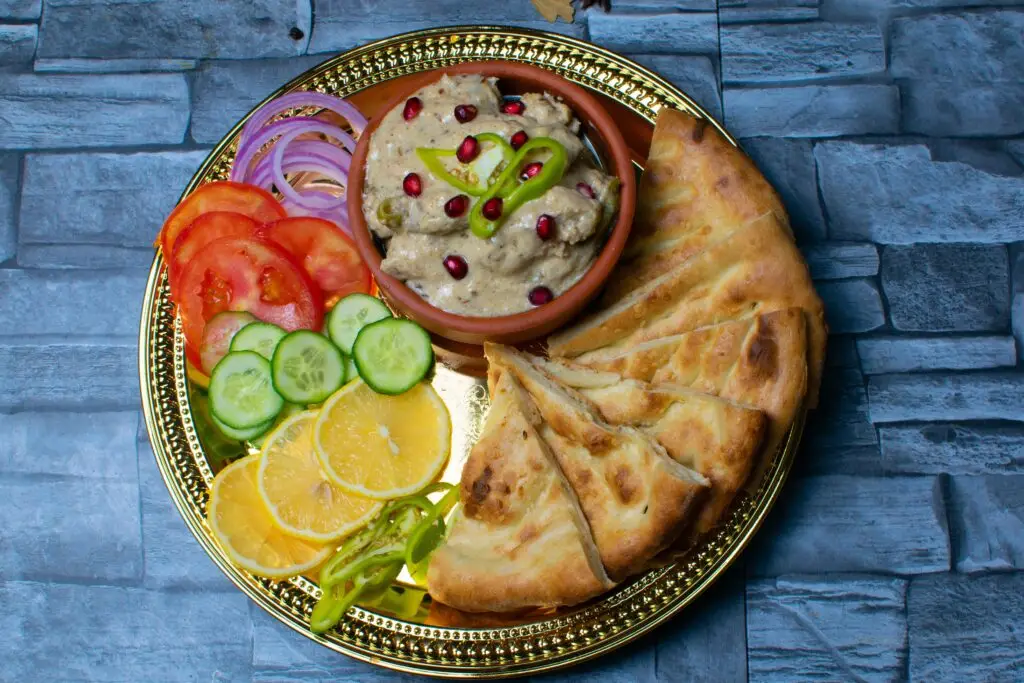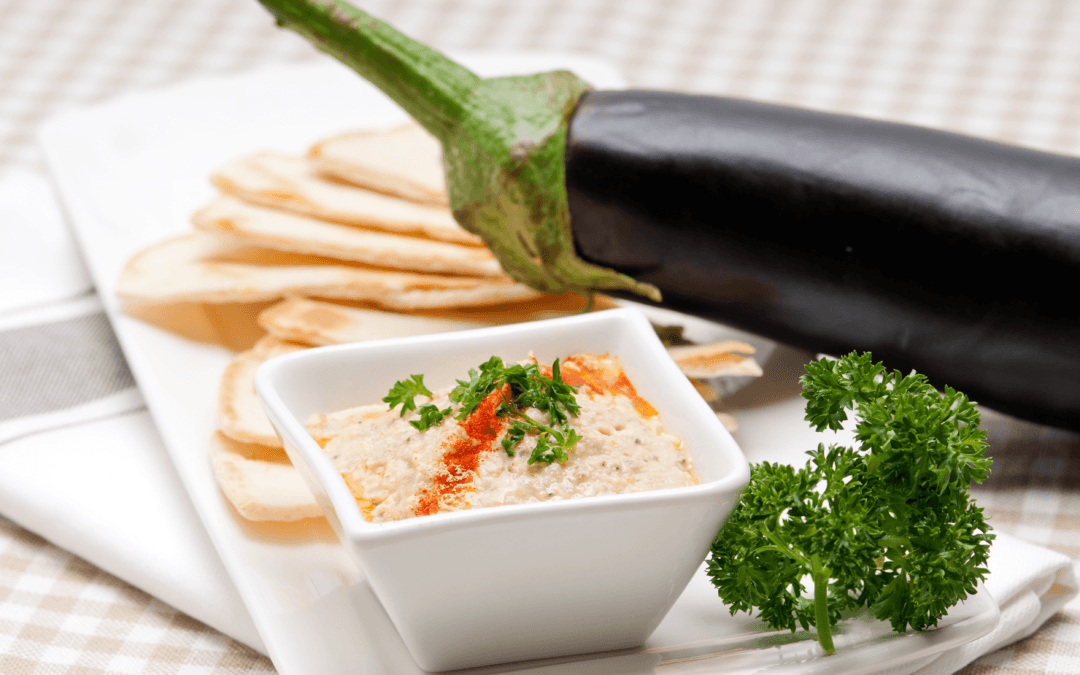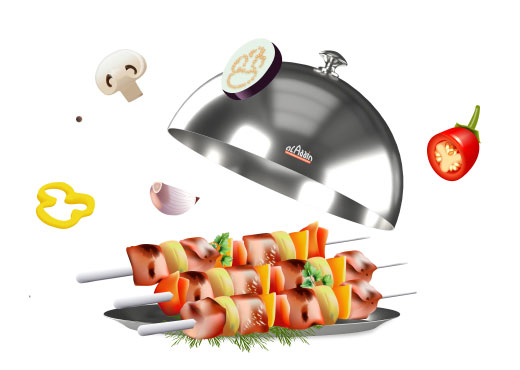Introduction to Baba Ganoush
Baba Ganoush is a super tasty and creamy dip made from eggplants. It’s a traditional Mediterranean dish that’s fun to make and even more fun to eat! Imagine scooping this smoky, flavorful dip with pita bread or fresh veggies. Yum!
A Brief History of Baba Ganoush
Baba Ganoush has been around for a long time. It comes from the Levant region, which includes countries like Lebanon, Syria, Jordan, and Israel. The name “Baba Ganoush” means “pampered papa” or “spoiled daddy,” which is pretty cool. This dip has become super popular in Middle Eastern and Mediterranean cuisine. It is often served with falafel, hummus, tabbouleh, and other yummy dishes.
Popularity of Baba Ganoush in Mediterranean Cuisine
Baba Ganoush is loved all around the world. Its rich, smoky flavor and creamy texture make it a favorite in many homes and restaurants. In Mediterranean cuisine, it’s often served with pita bread, fresh veggies, or as part of a mezze platter. It’s versatile and super delicious, so food lovers everywhere can’t get enough of it.

Homemade Baba Ganoush Recipe
Ingredients
- 2 large eggplants
- 1 cup grilled eggplant pulp (finely chopped)
- 15 grams tahini
- 2 grams garlic (finely chopped)
- 15 ml olive oil (plus extra for garnish)
- 10 ml lemon juice
- 2 grams paprika
- Salt to taste
- Optional Garnishes: olives, olive oil, parsley
Instructions
Grill the Eggplants
- Preheat your grill or oven to medium-high heat.
- Pierce the eggplants several times with a fork.
- Place the eggplants on the grill or in the oven and cook for about 15 minutes, turning occasionally, until the skin is charred and the flesh is tender.
Prepare the Pulp
- Once the eggplants are grilled, let them cool slightly.
- Cut the eggplants open and scoop out the pulp. Discard the skin.
- Finely chop the pulp to get about 1 cup.
Combine the Ingredients
- Combine the chopped eggplant pulp, tahini, garlic, olive oil, lemon juice, paprika, and salt in a mixing bowl.
- Mix well until all the ingredients are thoroughly combined.
Garnish and Serve
- Transfer the Baba Ganoush to a serving dish.
- Garnish with olives, a drizzle of olive oil, and chopped parsley.
- Serve with pita bread.
Enjoy your homemade Baba Ganoush!
How to Choose the Best Eggplant

Picking the best eggplant is super essential for making yummy Baba Ganoush. Look for eggplants that are firm with smooth, shiny skin. Avoid ones with blemishes or soft spots. The eggplant should feel heavy for its size, which means it’s nice and fresh.
Preparing the Eggplant
Roasting the Eggplant
Roasting the eggplant gives Baba Ganoush its unique smoky flavor. Here’s how to do it:
- Preheat your oven to 400°F (200°C).
- Prick the eggplant several times with a fork.
- Place the eggplant on a baking sheet and roast for 30-40 minutes, turning occasionally, until the skin is charred and the flesh is tender.
Alternative Cooking Methods: Grilling and Baking
If you don’t have an oven, you can grill the eggplant. Place it directly on the grill grates and cook, turning occasionally, until the skin is charred and the flesh is soft. Another option is to bake it. Wrap the eggplant in aluminum foil and bake at 400°F (200°C) for 30-40 minutes.
Peeling and Draining the Eggplant
Once the eggplant is cooked, let it cool slightly. Cut off the stem and peel away the charred skin. Place the peeled eggplant in a colander to drain any excess moisture. Let it drain for 10-15 minutes, pressing gently with a spoon to remove as much liquid as possible.
Importance of Removing Excess Moisture

Removing extra moisture from the eggplant is super important. Too much moisture can make Baba Ganoush runny instead of creamy. Draining the cooked eggplant helps concentrate its flavors and ensures a smooth, luscious texture.
Tips for Easy Peeling
Peeling roasted or grilled eggplant can be messy. Let the eggplant cool enough to handle safely. Use your fingers or a spoon to peel away the skin gently. If there are any stubborn bits, a paring knife can help remove them.
Achieving the Ideal Texture
The perfect texture for Baba Ganoush is creamy and smooth. If you prefer a very smooth dip, use a food processor to blend the eggplant and tahini mixture until it reaches the desired consistency. Adjust the seasoning with salt and lemon juice to taste.
Seasoning Your Baba Ganoush
Traditional Seasonings
Traditional seasonings for Baba Ganoush include garlic, lemon juice, and olive oil. These ingredients complement the eggplant’s smoky flavor and the tahini’s richness. Salt and pepper are added to taste.
Experimenting with Flavors
You can also experiment with different flavors. Add spices like cumin, smoked paprika, or chili flakes for some heat. Fresh herbs like parsley or cilantro can add a burst of freshness. Try a drizzle of pomegranate molasses or a handful of pomegranate seeds as a garnish for sweetness.
Serving Suggestions
Traditional Accompaniments
Baba Ganoush is typically served as a dip with pita bread or chips. It pairs beautifully with fresh vegetables like cucumber, bell peppers, and carrots. It’s also commonly included in mezze platters alongside other Mediterranean favorites like hummus, tabbouleh, and dolmas.
Modern Serving Ideas
You can also get creative with how you serve Baba Ganoush. Spread it on sandwiches or wraps for a flavorful alternative to mayonnaise or mustard. Use it as a topping for grilled meats or roasted vegetables. It can even be stirred into pasta or grain salads for a creamy, flavorful dressing.
Storing Baba Ganoush

Best Practices for Refrigeration
To store Baba Ganoush, transfer it to an airtight container and refrigerate. It will keep well for up to 4-5 days. Before serving, stir it well and check the seasoning.
How Long Does Baba Ganoush Last?
While Baba Ganoush can last up to 4-5 days in the refrigerator, it’s best enjoyed fresh. Over time, the flavors can become less vibrant, and the texture may change slightly. If the dip has become too thick after refrigeration, stir in a small amount of olive oil or water to restore its creamy consistency.
Common Mistakes to Avoid
Overcooking the Eggplant
One common mistake when making Baba Ganoush is overcooking the eggplant. Overcooked eggplant can become mushy and lose its structure, resulting in a dip that is too soft in texture. To avoid this, monitor the eggplant closely while roasting or grilling, ensuring it’s cooked until tender but still holds its shape.
Incorrect Seasoning Balances
Another mistake is incorrect seasoning balances. Too much lemon juice can make the dip overly tangy, while too much garlic can overpower the other flavors. Taste the Baba Ganoush as you mix the ingredients and adjust the seasoning gradually.
Tips for Perfect Baba Ganoush Every Time
Consistency Tricks
Achieving the perfect consistency for Baba Ganoush can be tricky, but a few tricks can help. Drain the eggplant thoroughly after roasting to remove excess moisture. When combining the eggplant with the tahini mix, add the mix gradually and adjust as needed to reach the desired creaminess.
Flavor Enhancement Techniques
To enhance the flavor of your Baba Ganoush, consider roasting the garlic along with the eggplant. This will mellow the garlic’s sharpness and add a sweet, caramelized flavor. Another technique is to drizzle a bit of high-quality extra virgin olive oil over the finished dip just before serving, adding a rich, fruity note.
Conclusion
Recap of the Homemade Baba Ganoush Recipe
Making Baba Ganoush at home is a rewarding experience that allows you to enjoy this delicious Mediterranean dip fresh from your kitchen. By selecting the right eggplant, properly roasting and peeling it, and carefully combining it with tahini and seasonings, you can create a creamy, smoky dip that is perfect for any occasion.
Encouragement to Experiment and Enjoy
Feel free to experiment with different flavors and ingredients to make the Baba Ganoush your own. Whether you stick to the traditional recipe or try new variations, this versatile dip will become a favorite. Enjoy it with friends and family, and explore how it can enhance your meals.
For those who want to enjoy Baba Ganoush without the effort of making it at home, we have a delicious, authentic version available for takeout. Check out Aladdin’s To-Go Menu to order Baba Ganoush and other Mediterranean dishes online.
Are you planning an event or gathering? Visit Aladdin’s Catering Menu for more information on bringing Mediterranean flavors to your next event.
Frequently Asked Questions
Can You Make Baba Ganoush Without Tahini?
Yes, you can make Baba Ganoush without tahini. While tahini adds a distinctive nutty flavor, you can substitute it with other ingredients, such as Greek yogurt, or even omit it altogether for a lighter dip.
What Are Some Variations of Baba Ganoush?
There are many variations of Baba Ganoush. Some recipes incorporate roasted red peppers, tomatoes, or spices to create unique flavor profiles. Another variation is Mutabbal, similar to Baba Ganoush but includes yogurt for a creamier texture.
How Can You Reduce the Bitterness of Eggplant?
To reduce the bitterness of eggplant, you can salt it before cooking. Slice the eggplant and sprinkle it with salt, then let it sit for about 30 minutes. Rinse the salt off and pat the eggplant dry before roasting or grilling. This process helps draw out the bitter compounds.
Is Baba Ganoush Vegan?
Yes, traditional Baba Ganoush is vegan and made with plant-based ingredients. To keep the dish plant-based, ensure the tahini and any added seasonings or garnishes are vegan.
Can You Freeze Baba Ganoush?
Baba Ganoush can be frozen, but the texture may change slightly upon thawing. To freeze, place the dip in an airtight container, leaving some space for expansion. It can be stored in the freezer for up to 3 months. Thaw in the refrigerator and stir well before serving.



